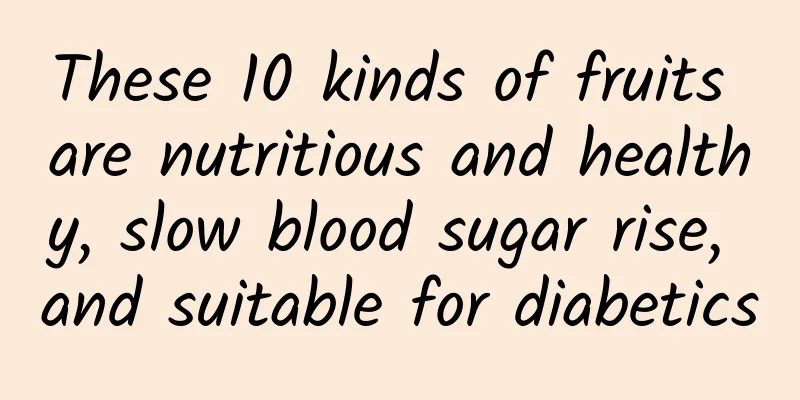These 10 kinds of fruits are nutritious and healthy, slow blood sugar rise, and suitable for diabetics

|
Fruits can provide the human body with rich vitamins, minerals and dietary fiber, but many diabetic patients dare not eat them for fear that eating them will cause a surge in blood sugar. However, according to a study analyzing 20,000 diabetic patients, the risk of poor blood sugar control for those who eat fruit is reduced by 20% to 30% compared with those who do not eat fruit. It can be seen that, **diabetics can eat fruits, but they should be very careful when choosing fruits! **There are so many kinds of fruits, how should diabetics choose? Today I recommend 10 kinds of fruits that are both delicious and slow to raise blood sugar~ 01Grapes Although grapes taste sweet, their glycemic index (GI) is only 43, making them a low GI food. And the glycemic load (GL) of eating 100 grams of grapes is only 4.4. Taking the Mare's Milk grapes with a low sugar content as an example, every 100 grams of Mare's Milk grapes consumed may consume about 9.9 grams of sugar. Mare's Milk grapes and Red Rose grapes are more suitable for diabetics; Qingwang grapes and Qingti grapes are not recommended because the sugar content of these two types of grapes exceeds 18%, which is twice that of Mare's Milk grapes. Therefore, diabetics can eat 100-200 grams of low-sugar grapes as a snack. 02 Watermelon Many people think that watermelon tastes sweet and must have a high sugar content. But in fact, the sugar content of watermelon is not too high, because the GI of watermelon is 72, and the available carbon water content is 6.6 grams per 100 grams. So if you eat 100 grams of watermelon, the corresponding GL is only 4.75. Therefore, it is okay for diabetic patients to eat 100-200 grams of watermelon as a snack , and it will not cause a big fluctuation in blood sugar. If you control the amount, you can eat it with confidence. 200 grams is actually just two palms. If you think it is not enough, you can arrange a maximum of 300 grams, but you must pay attention to eating it in 2 times, not all at once, such as 150 grams in the morning and afternoon. However, the only thing to note is: don't squeeze the juice! Otherwise, if you drink it down, your blood sugar may soar. 03Apple There are many kinds of apples, and almost all diabetics can eat them. Eating an apple the size of a fist every day is a suitable amount. If you have requirements for the time of lowering blood sugar, such as wanting to lower blood sugar after a meal, the best time to eat apples is about 30 minutes before a meal, or as a snack between meals. 04 Peach The glycemic index of peaches is 28, which means that eating a medium-sized (200 grams) peach has a glycemic load of about 6. Peaches are a "blood sugar-friendly" fruit, very suitable for diabetics. It is recommended to eat hard peaches, which are digested and absorbed more slowly. 05 Apricot Apricots are a good source of fiber, and 4 apricots can provide 10% of the daily intake. The GI value of apricots is 31, and the GL value is 2.8, both of which are in the low range. As long as the daily intake is moderate, diabetics can eat it. 06 Strawberry Many studies have shown that strawberries are more suitable for diabetic patients. Anthocyanins in strawberries can reduce glucose absorption and increase insulin secretion, and polyphenol compounds in strawberries can improve the cardiovascular health of diabetic patients and reduce the risk of cardiovascular complications. It is recommended that diabetics control their daily strawberry intake within 200 grams, preferably 8 to 10 strawberries. 07 Cherry Cherries are rich in pectin, which helps secrete insulin and lower blood sugar. The GL value of 100 grams of cherries is only 2.2, so you can eat them without worry. It is recommended to eat 100 to 200 grams of cherries every day. In addition, cherries are also rich in potassium, with a potassium content of 232 mg, which is comparable to bananas, and is more friendly to people who need to control blood pressure. 08 Orange Oranges are rich in vitamin C, and daily vitamin C supplementation is good for immune function, mood regulation and skin health, and its pulp can provide a lot of dietary fiber. Oranges also provide a lot of water and minerals, which not only satisfies thirst, but also helps regulate blood pressure and muscle function. 09 Grapefruit The GI value of grapefruit is 25, which is a low GI food. The GL of 100 grams of grapefruit is 2.3. If you can get a peeled grapefruit in autumn, eat it with confidence. The vitamin C content of grapefruit is also good. Eating 200 grams of grapefruit can provide 46 mg of vitamin C, which can meet 46% of the daily vitamin C requirement of an average adult. This is also a wonderful thing! However, it should be noted that it is best not to eat fruits such as grapefruit with medicine to avoid affecting the effect of the medicine or causing physical discomfort. If you want to eat it, at least 2 hours apart. 10 cherry tomatoes Cherry tomatoes are high in vitamins and low in sugar, with a sugar content of 5.8% per 100 grams, making them very suitable for diabetics. Diabetics can eat a few cherry tomatoes every day as a snack or between meals to satisfy their cravings without worrying about rising blood sugar levels. They can also help prevent osteoporosis and high blood pressure. "Five grains for nourishment, five fruits for assistance." Eating fruits in moderation can not only meet nutritional needs, but also indirectly control high blood sugar, and diabetics can also gain a sense of happiness. Reference: Li L, Yang HY, Ma Y, et al. Whole fresh fruit intake and risk of incident diabetes in different glycemic stages: a nationwide prospective cohort investigation. Eur J Nutr. 2022 Oct 19. |
<<: When grass sprouts, hundreds of diseases will occur! Beware of these common diseases in spring
Recommend
Five major causes of low back pain in women
Low back pain is a common problem in life. Women ...
Stretch Marks Treatment
Every pregnant woman may experience stretch marks...
Can I drink mutton soup after miscarriage?
After an abortion, in order to restore the body t...
Can pregnant women light mosquito coils when sleeping?
Summer is the most painful thing. The weather is ...
Normal range of cervical length in pregnant women
Everyone's physical development is different,...
Attention! If you lose your teeth at a young age, this dental disease may be to blame
March 20, 2025 is the 19th World Oral Health Day....
What is the size of the gestational sac at 40 days of pregnancy?
The gestational sac at 40 days of pregnancy can b...
A little education on cardiopulmonary exercise testing
Based on the " Cardiopulmonary Exercise Test...
The flesh on the girl's neck
For many women, a slim figure is what they have a...
How to deal with pregnancy after IUD insertion
In life, different people choose contraceptive me...
How can pregnant women avoid stretch marks?
Many pregnant women gain too much weight during p...
How can hcg be tested to determine whether it is an ectopic pregnancy?
Compared with normal pregnancy, ectopic pregnancy...
Is baking soda solution good for vaginal douches?
Women's body structure is very complex, and t...
Early pregnancy hcg to determine the quality of the embryo
Many pregnant mothers did not study seriously whe...









